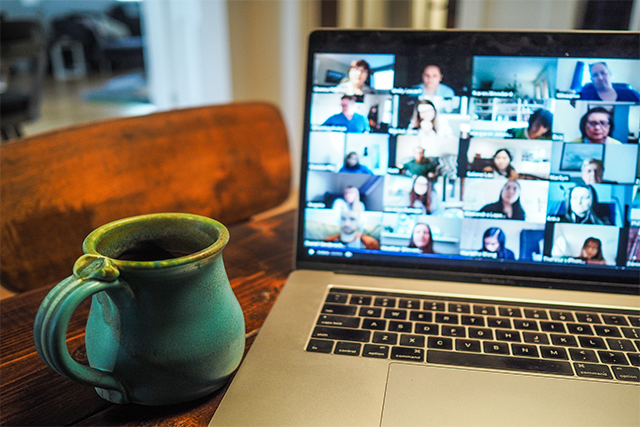Many professionals, including academics, are accustomed to flying a lot. Or they were before COVID-19 drastically reduced air travel and disrupted conference plans globally. For now, the mingling of many people in hotel conference rooms, flown in from many places, isn’t an option.
Conferences are increasingly being organized online. What this should look like and what changes it implies for the nature of professional networks and knowledge-sharing remains to be seen.
But smart design choices can translate into significant gains in the sustainability, accessibility and the insights people can gain from conferences in the COVID-19 era and beyond.
Online conferencing provides new opportunities to broaden conversations and invite more inclusive feedback. Our work is interested in how low-carbon research practices can be good for the planet and good for research outcomes.
Costs of travelling
Being and working together, particularly in smaller workshop settings, is an invaluable way to generate new ideas and connections in many fields and professional settings. But older models of gathering, particularly in their scale and carbon intensity, have drawbacks that we can no longer afford to ignore.
Flying was a fraught proposition before the pandemic. Air travel contributes to environmental injustices in communities located near airports and on the front lines of climate change.
Travel requirements also exclude many from participation, whether it’s due to high costs, border restrictions, accessibility challenges or pressures on participants with care responsibilities. Not everyone can travel. Certainly, not everyone should. Many of us, particularly in the Global North, need to travel much less.
Planes aside, both in universities and beyond, some people are increasingly wondering if conference conventions are serving them well.
Is a brief talk within a marathon of other presentations really worth it? Are there other ways to gather that might do more for knowledge-sharing and the planet?
(Jakub Gorajek/Unsplash), CC BY
New models, new possibilities
The good news is there’s no need to reinvent the wheel. Researchers attuned to the environmental and equity challenges of flying have been experimenting with alternative formats for years.
The Nearly Carbon Neutral Conference, run by professor of environmental humanities Ken Hiltner at the University of California Santa Barbara, is one example. The conference hosts video talks on YouTube and WordPress — a format that dramatically lowers participation costs.
The Society for Cultural Anthropology and the Society for Visual Anthropology offer another model: their joint biennial conference runs as an eight-hour loop of video content, broadcast to international nodes with supports available to participants in the Global South. Both formats boast strong registration numbers, significant reach and improved accessibility standards.
Other gains are possible through more experimental approaches. A workshop we organized earlier this year, Energy In/Out of Place, succeeded in connecting five research teams and more than 100 attendees, all without registration fees. Presenters shared multimedia projects and highlighted inventive ways of producing work for digital distribution.
These and other examples suggest that we have opportunities to redesign and repurpose conferences to reduce carbon emissions and improve knowledge-sharing. This will require an approach to event planning that does not seek merely to replicate in-person conventions, but to explore the unique capacities of online events.
Make the most of going online
Here are three ways to yield the benefits of going online.
1. Plan written feedback for richer sessions.
Conventional academic conference panels offer limited time for feedback: typically less than five minutes per paper. This time can easily be eaten up by questions that, as speakers often note, “are more of a comment, actually.”
Online events can be designed to emphasize written feedback — via synchronous chat or asynchronous comment threads — ensuring more varied and coherent responses than on-the-spot verbal remarks. Attendees routinely comment that this is a major selling point of e-conferences.
2. Plan for accessibility from the start.
Disabled designers and advocates have long used digital tools to meet and work remotely. We should learn from disability culture’s technologies, protocols and best practices to make online gatherings more accessible than traditional conferences ever were. If your conference didn’t include image descriptions, captions and translations before, it certainly can now.
Better access can also boost diversity. Lower fees mean more under-represented scholars or attendees can get in the virtual room. E-conference organizers might also use funding earmarked for travel expenses to fund research and the creation of new media to share research directly, as we did with the conference we planned.
3. Make creative use of new presentation formats.
E-conferences’ heavily mediated nature has the potential to rewrite the conventional, and often monotonous, Powerpoint presentation. Ranging from small gestures (like recording a talk from a field site) to grand ones (like composing video essays), e-conferences can use the capacities of digital media for inquiry and expression. Such an approach dovetails with research-creation, a framework that challenges researchers to articulate their arguments in accessible or esthetically engaging ways.
The work ahead
Digital distractions, energy-intensive streaming, security risks, entanglement with surveillance capitalism and capturing the creative energy of in-person gatherings are all difficulties faced by e-conference organizers.Pursuing these benefits doesn’t mean they’re guaranteed, nor will these efforts come without hazards.
They’re significant, but not insurmountable. We’ve recently written a short, accessible report highlighting several ways to meet these challenges. This is a road we build by walking.
All in all, the disruptions of COVID-19 present an opportunity to rethink how we do conferences and workshops: to ask what they are for, who they benefit and how we can improve them, hopefully in ways that permanently reduce the amount of travel we do in a post-pandemic world.
Caleb Wellum, Energy Futures Postdoctoral Fellow, University of Alberta; Anne Pasek, Assistant Professor and Canada Research Chair in Media, Culture, and the Environment, Trent University, and Emily Roehl, Lecturer, Honors College, Texas State University. This article is republished from The Conversation under a Creative Commons license. Read the original article.

